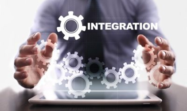SAP Process Orchestration
Filter By
Browse By
- SAP Analytics and AI
- SAP Application Development and Integration
- All SAP Application Development and Integration
- SAP ABAP
- SAP ABAP Development Tools
- SAP ABAP Test Cockpit
- SAP API Management
- SAP BAPI
- SAP Basis
- SAP BRF
- SAP Business Application Studio
- SAP CMS
- SAP Design Studio
- SAP Development Tools
- SAP DevOps
- SAP EAI
- SAP EDI
- SAP Extension Suite
- SAP Fiori
- SAP Fiori Elements
- SAP Integration Suite
- SAP Low Code Application Development
- SAP Low Code Automation
- SAP Netweaver
- SAP Release Management
- SAP UI5
- SAP Web Application Server
- SAP Web IDE
- SAP Business Process Management
- SAP Center of Excellence
- SAP CIO
- SAP Customer Experience
- SAP Data and Data Management
- All SAP Data and Data Management
- SAP BW
- SAP BW/4HANA
- SAP Crystal Reporting
- SAP Data Archiving
- SAP Data Center
- SAP Data Governance
- SAP Data Integration
- SAP Data Migration
- SAP Data Quality
- SAP Data Services
- SAP Data Strategy
- SAP Data Visualization
- SAP Data Warehouse Cloud
- SAP DMS
- SAP Document Control
- SAP EIM
- SAP ETL
- SAP ETL Tools
- SAP HANA
- SAP HANA Administration
- SAP HANA Deployment Infrastructure
- SAP HANA Studio
- SAP Master Data
- SAP Master Data Governance
- SAP MDM
- SAP Enterprise Architect
- SAP Enterprise Asset Management
- SAP ERP
- SAP Finance
- All SAP Finance
- SAP Accounting
- SAP AR AP
- SAP Asset Accounting
- SAP Billing Systems
- SAP BPC
- SAP BRIM
- SAP Cash Management
- SAP Central Finance
- SAP Controlling
- SAP COPA
- SAP Cost Center Accounting
- SAP e-invoicing
- SAP FICO
- SAP Finance Automation
- SAP Financial Closing Cockpit
- SAP Financial Consolidation
- SAP Financial Planning
- SAP FX Risk
- SAP General Ledger
- SAP Global Tax Management
- SAP Hyperion
- SAP Order to Cash
- SAP Payment Processing
- SAP Profitability Analysis
- SAP Rebate Management
- SAP S/4HANA Finance
- SAP Universal Journal
- SAP Governance Risk and Compliance
- SAP Human Capital Management
- SAP Intelligent Technologies
- SAP Platform and Technology
- All SAP Platform and Technology
- SAP Business Technology Platform
- SAP Cloud Connector
- SAP Cloud Integration Platform
- SAP Cloud Migration
- SAP Cloud Platform
- SAP Cloud Providers
- SAP Cloud Strategy
- SAP Container Platform
- SAP Digital Asset Management
- SAP Digital Integration Hub
- SAP Digital Signature
- SAP HANA Enterprise Cloud
- SAP HEC
- SAP Hyperscalers
- SAP Infrastructure
- SAP Messaging
- SAP Smart Forms
- SAP Quality and Testing
- SAP Security
- SAP Spend Management
- SAP Supply Chain Management
- All SAP Supply Chain Management
- SAP APO
- SAP Asset Management
- SAP Business Network
- SAP Digital Manufacturing Cloud
- SAP Digital Twin
- SAP EWM
- SAP IBP
- SAP Inventory Management
- SAP Label Printing
- SAP Logistics
- SAP Manufacturing
- SAP Manufacturing Automation
- SAP MES
- SAP MII
- SAP MM
- SAP MRO
- SAP MRP
- SAP Order Management
- SAP Plant Maintenance
- SAP PLM
- SAP Production Planning
- SAP S&OP
- SAP SD
- SAP SPM
- SAP Supply Chain Planning
- SAP Track and Trace
- SAP Transportation Management
- SAP System Administration
What is Process Orchestration?
Businesses run on a plethora of business processes. In today’s rapidly digitizing world, it means that they may need to be supported by a multitude of systems. To build best-of-breed processes, organizations need to understand their current state better and make sure that it’s well orchestrated. While point systems may be capturing data, this data is fragmented and does not provide a holistic view of the end-to-end data flow. Process orchestration ensures that these disparate data sources work in sync with each other, when required, with data sharing and a combined intelligence and analytics platform. This provides organizations with the required insights to reduce friction, identify efficiency opportunities, and build best-in-class processes within a combined portfolio.
What is Process Orchestration?
Businesses run on a plethora of business processes. In today’s rapidly digitizing world, it means that they may need to be supported by a multitude of systems. To build best-of-breed processes, organizations need to understand their current state better and make sure that it’s well orchestrated. While point systems may be capturing data, this data is fragmented and does not provide a holistic view of the end-to-end data flow. Process orchestration ensures that these disparate data sources work in sync with each other, when required, with data sharing and a combined intelligence and analytics platform. This provides organizations with the required insights to reduce friction, identify efficiency opportunities, and build best-in-class processes within a combined portfolio.
Examples of Process Orchestration Tools Available in SAP ecosystem
There are several process orchestration tools available in the SAP ecosystem. SAP’s acquisition of Signaviolast year illustrates the growing importance of process intelligence. Due to the rising importance, there are now several vendors in this space, including key ones like SAP, Celonis, Kofax, UiPath, IBM, and Worksoft. Some of these vendors offer a comprehensive solution that encompasses a wide range of business processes whereas others are focused on a subset of processes.
Key Considerations for SAPinsiders
- Develop a process orchestration strategy. This is a step you need to finalize even before you start evaluating tools you need. The first sub-step is to understand which processes are interconnected and hence need to be in sync and orchestrated. The second sub-step is to define how this orchestrated capability will interface with other applications like your business intelligence tools or control towers. You then also need to understand the role analytics will play in your process intelligence strategy.
- Understand the strengths of orchestration tools available. While they all fall into the same category, these tools have different unique selling propositions. It is imperative for you to understand these strengths as that will aid you to understand which tools will fit your needs. A good approach is to evaluate use cases like this to understand if the tool has been leveraged extensively in your domain.
- Leverage tools beyond vanilla process intelligence. Leverage tools for initiatives beyond day-to-day process intelligence. SAP S/4HANA migration is a great example, considering that organizations see this as a challenging initiative. As detailed in this white paper, a process mining and intelligence platform can help you capture your current processes to facilitate and accelerate the migration.
1037 results
-

mySAP CRM Analytics Harnesses SAP NetWeaver BI Analytical Capabilities
Published: 01/February/2007
Reading time: 25 mins
mySAP CRM Analytics, a group of tools offered with mySAP CRM and SAP NetWeaver BI, can help you optimize your company’s customer data. Learn about the mySAP CRM extraction mechanism and delivered analysis tools you can use with your data. Then, explore the standard tool sets available, including customer analytics, product analytics, sales and service...…
-

SAP Completes Strong Q2, Eyes APJ Expansion with Alibaba Partnership
Published: 24/July/2025
Reading time: 6 mins
SAP reported strong Q2 2025 earnings with cloud revenue up 24% to €5.1 billion, bolstered by a strategic partnership with Alibaba to enhance growth in the Asia-Pacific region and the impact of AI on revenue, while completing a major restructuring that involved 10,000 employees.
-

What’s New in mySAP CRM 2005
Published: 15/November/2005
Reading time: 14 mins
Discover the enhancements offered in mySAP CRM 2005, which SAP expects to release by the end of the year. Also find out what is involved with an upgrade to mySAP CRM 2005, whether you are new to SAP CRM or you use SAP CRM 2.x, SAP CRM 3.x, or SAP CRM 4.x. Key Concept mySAP...…
-
-

Select the Right Time-Evaluation Starter Schema: Part 3
Published: 15/March/2005
Reading time: 20 mins
Time-evaluation functions TIMTP and TYPES are a transition point between raw time data and time results in SAP time evaluation. You’ll see how understanding TIMTP and TYPES helps you select the most relevant time-evaluation starter schema. Key Concept Time wage types are generated by time evaluation and stored in the time results. The SAP Payroll...…
-

Extending Business Processes with SAP Forms Service by Adobe
Published: 03/May/2025
Reading time: 4 mins
A partnership between a London-based IT service provider and FPT to integrate SAP Forms Service by Adobe within SAP Business Technology Platform has successfully customised output forms in SAP S/4HANA Cloud, resulting in enhanced operational efficiency, improved user experience, and streamlined business processes in Sales and Distribution and Materials Management.
-

Pruftechnik: Reengineering Master Data with Process Runner
Reading time: 3 mins
Pruftechnik enhanced its migration to SAP S/4HANA by utilizing insightsoftware’s Process Runner for automating data management and reengineering master data, significantly improving agility and efficiency across 40 processes and 300,000 records.
-

Why Integrating SAP and Non-SAP Systems is No Longer Optional
Published: 29/April/2025
Reading time: 3 mins
The modern enterprise landscape is shifting towards a hybrid model where 52% of organisations now use SAP alongside a diverse range of third-party applications, highlighting the critical need for effective integration strategies to optimise functionality and streamline processes amid increasing complexity.
-
-

Simplify Your Rebate Process with Extended Rebate Agreements
Published: 11/July/2011
Reading time: 10 mins
Learn how to set up extended rebate agreements and use them in various business scenarios such as offering rebates to multiple recipients in a single agreement or reaching a settlement of rebate agreements for specific materials or particular periods. Key Concept When a company pays rebates to multiple hierarchy customers, then, in standard rebate processing,...…
-

Issue Certificates of Origin by Using Preference Processing Functionality in SAP BusinessObjects Global Trade Services 8.0
Published: 09/March/2011
Reading time: 12 mins
Learn how SAP BusinessObjects Global Trade Services issues certificates of origin or vendor declarations for claiming reduced customs duties on your products subject to North American Free Trade Agreement (NAFTA) or European Union (EU) trade regulations. See how the enhanced archiving capabilities for preference determination are used for audits. Also, learn what preference processing configuration...…
-

Meeting Modern Data Protection Requirements
Published: 24/August/2017
Reading time: 15 mins
As the volume of data collected by organizations continues to increase, so too do regulations designed to protect data from misuse, particularly when it comes to personal data. One of these is the European General Data Protection Regulation (GDPR), which goes into full effect on May 25th, 2018, and has global implications — it applies…
Become a Member
Unlimited access to thousands of resources for SAP-specific expertise that can only be found here.
Upcoming Events
-

Mastering SAP Collaborate an SAP TechEd on Tour event
November 12 - 14, 2025
Sydney, New South Wales
Australia
View Event
Your request has been successfully sent